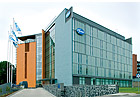
This office building located in Helsinki, Finland, has large surface area of windows, skylights, and a large atrium. The huge amount of glass drove the building’s owners to employ CFD software to simulate interior airflow and experiment with various diffuser configurations and clear up concerns about thermal comfort.
Olof Granlund Oy is the largest building services design and consulting company in Finland, employing about 270 people. The company was asked to evaluate and, if necessary, improve the comfort level of a new office building in Helsinki, Finland.
The 150,000-sq-ft building is the headquarters for Pfizer Oy, the Finnish subsidiary of Pfizer Inc. The building uses an active chilled beam cooling system from Swegon BRC for office spaces and displacement ventilation for the lobby.
The designers were concerned about thermal comfort because of the large surface area of windows and skylights and the large atrium. While many people think of Finland as a very cool climate, the Helsinki area actually has a greater solar thermal load during the summer than Paris.
“Keeping the atrium warm enough is difficult in the winter because of the large window and skylight area,” said Sami Lestinen, CFD specialist for Granlund. “On the other hand, keeping the atrium cool in the summer months is challenging because skylight and windows provide a significant solar heat source to the atrium.”
Putting The EAP To Work
In the past, Granlund would have used only an energy analysis program (EAP) that is primarily intended to evaluate energy usage and cost and thus can only predict average temperatures for a particular space. “In the past, about all that consultants could do was to make sure the average temperatures were right and hope that there wasn’t too much variation,” said Tuomas Laine, manager of research and development for Olof Granlund Oy.“The real risk faced by the building owner was that after the building was finished, the occupants would report major heating and cooling problems. It would then be necessary to go through a lengthy and expensive trial and error process in order to remedy the problem. The owner asked us to use advanced tools such as computational fluid dynamics (CFD) in order to avoid this kind of headache,” Laine said.
“We used ANSYS® CFX® CFD software, from ANSYS Inc., to simulate airflow within the building because we have found that it can quickly and easily model the complex geometries found in most large building projects,” he added.
Lestinen created the model by importing the CAD geometry of the building in IFC format into ANSYS CFX and generating an unstructured tetrahedral mesh. One of the challenges in modeling indoor thermal conditions is the need to account for small-scale supply air diffusers, while at the same time accommodating large open areas of the atrium. He added mesh controls to the areas with large gradients near supply air devices and heat sources, and then set the mesh density to an appropriate value. This approach made it possible to provide high levels of accuracy in a critical area while keeping the model to a reasonable size of 600,000 nodes and 3 million elements.
Accounting For The Sun's Loading
“When we looked at the simulation results of different air distribution solutions, we were able to diagnose the system for air distribution throughout the building,” Lestinen said. “One general problem was that air velocities were too high for comfort in a number of occupancy zones. Temperatures were too high in certain areas of the atrium during the summer due to the large amount of solar thermal loading through the skylights. We also noticed that optimization of supply air distribution in offices was important for thermal comfort.”“We addressed the airflow problem and the heat distribution in the atrium by evaluating a number of different diffuser configurations,” Lestinen continued. “We finally found a diffuser design that reduced airflow to comfortable levels while improving thermal distribution to the point that the temperature remained within an acceptable range in all occupied areas of the atrium under summer conditions. We also modeled a variety of different window heating systems until we found one that solved the problems.”
“Computer simulation significantly improved the indoor air quality of this building while avoiding the expense that would have otherwise been required to modify the HVAC system after it had already been installed,” Laine added.
